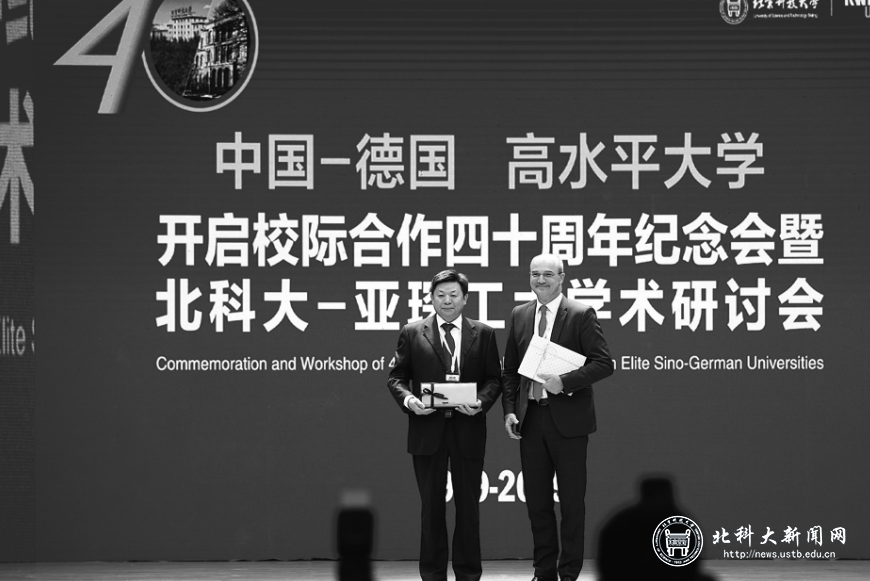
President of the University of Science and Technology Beijing, Yang Renshu (left), exchanges gifts with Ulrich Ruediger, rector of RWTH Aachen University, at a recent event in Beijing. PROVIDED TO CHINA DAILY
After 40 years, the fruits of cooperation between universities in China and Germany are evident, Xing Wen reports.
A key anniversary to mark the successful cooperation between leading Chinese and German universities was celebrated in Beijing,as the deep prosperous ties between two institutions look set to continue. The 40th anniversary commemoratingthe signing of a partnership agreement between the University ofScience and Technology Beijing and Germany’s RWTH Aachen University was held in the capital on Sept 21 to celebrate their mutual progress and outline a strategy for further collaboration.Professors from both universities took part in a forum held during the celebration.
As a pioneer in initiating intercollegiatecooperation with overseas universities after China’s implementationof reform and opening�-up began in 1978, USTB sent a delegation to Aachen and negotiated with the German faculty about how to establish and foster academic cooperationin fields related to the development of the steel and iron industry.
In May 1979, with approval fromthe State Council, the Beijingbased university officially signed a reciprocalagreement with RWTH. This ushered in an era of shared achievements in cultivating talent, scientific research and cultural exchanges.
Yang Renshu, president of USTB, points out that the universities shared their expertise in areas such as metallurgical engineering, materials science and mechanical engineering, allowing joint operations to flourish immediately.
Over the years, according to Yang, scholars and experts from both universities have made significant contributionsto the scientific and technological development of the two countries by jointly studying advanced materials, such as the use and application of automotive steel and metal processing.
According to Yang, nearly 400Chinese graduates of the university have pursued further education at the German institution. Meanwhile,groups of German students have taken part in exchange programs, every two years. Key among this group are those majoring in mining and metallurgy. They take up internships in factory workshops run by the university, visit Chinese enterprises and learn their output techniques. These include steelmaker Shougang Group, Shanghai-based Jiangnan Shipyard and electronics manufacturer Lenovo.
They also get a rich, first hand experience of traditional Chinese culture.
“Why is this partnership of such great value?’’ asks Reiner Kopp, a former rector of RWTH who is also a recipient of the Chinese Government Friendship Award. “I think the most important part is that both universities can con�tribute a great deal of research and various development activities to overcome challenging problems facing our world.”
Mao Weimin, a professor at the school of materials science and engineering of USTB, is among the beneficiaries of the cooperation. He obtained his doctorate from the institute of physical metallurgy and metal physics at RWTH in 1988.
“What I learned from the German university has laid a solid foundation for my future teaching and research work,” says Mao, who points out that, initially, it was mainly those faculties belonging to the Chinese university that could avail of the exchange opportunities to study in Germany.
Mao helped launch an exchange program to cater to students who wanted to go to Germany to study for a master’s degree. Mao noticed a trend that emerged in the 1990s — an increasing number of European students opted to study the social sciences instead of engineering. Consequently, RWTH faced the shortage of students who wanted to study engineering.
“However, during China’s openingup process, many Chinese families were able to afford to send their children to study abroad”, and this helped redress the balance, recalls Mao.
“I visited RWTH several times to see if it was possible for the university to enroll USTB’s engineering students and launch an English language program for them.‘’
In 2004, USTB started to select honors students majoring in materials science or metallurgy and send them to take up postgraduate programs in Germany.
The Chinese university also expanded its horizons. It later reached an agreement with the Catholic University of Leuvenin, Belgium. This allowed their students to pursue further education in Belgium.
USTB’s quality partnership with RWTH gave it an international outlook and reputation. Since 1979 it has cooperated with nearly 200 worldclass universities and insti�tutes including the University of Oxford in the United Kingdom and Oak Ridge National Laboratory in
the United States. Meanwhile, more than 8,000 international students have come to study at USTB.
This year, Luo Haiwen, a professor from USTB’s school of metallurgical and ecological engineering,has set up a joint project with research groups from the German school, which covers the properties and performance of manganese steel, a critical malleable metal
used for heavy industry, such as mining.
Luo adds that the public perception of the steel industry, as dangerous and dirty, seems to deter young people.
“As a workplace, a steel plant is obviously not as attractive as a fancy office building, or as glamorous as information technologyrelated sectors,” Luo says.
“This kind of stereotype about the steel and iron industry needs to be changed, and the importance of developing advanced materials to support new technology must be stressed.”
原文链接:《中国日报》(2019年10月9日)
(责编:孟婍)
 最新阅读
最新阅读 2025-11-21
2025-11-21 2025-11-17
2025-11-17 2025-10-31
2025-10-31 2025-10-17
2025-10-17 2025-10-11
2025-10-11 2025-09-29
2025-09-29 2025-09-25
2025-09-25 2025-09-23
2025-09-23 2025-09-18
2025-09-18 2025-09-12
2025-09-12